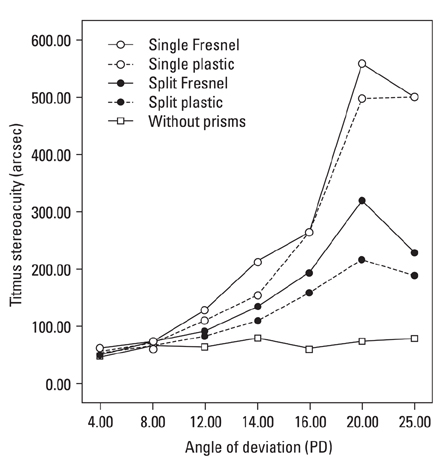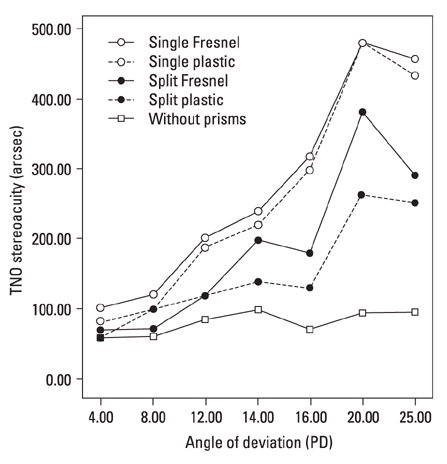Yonsei Med J.
2010 Jan;51(1):117-120. 10.3349/ymj.2010.51.1.117.
The Prismatic Effect on Stereoacuity in Intermittent Exotropia
- Affiliations
-
- 1Department of Ophthalmology, National Health Insurance Corporation Ilsan Hospital, Goyang, Korea. 491209@yuhs.ac
- 2Institute of Vision Research, Department of Ophthalmology, Yonsei University College of Medicine, Seoul, Korea.
- KMID: 1779616
- DOI: http://doi.org/10.3349/ymj.2010.51.1.117
Abstract
- PURPOSE
To evaluate the effect of acrylic refractive prism and Fresnel membrane prism on stereoacuity in intermittent exotropia. MATERIALS AND METHODS: Stereoacuities of fifty-two patients (mean age, 12.4 years; range 6 to 45 years) with intermittent exotropia were measured using the Titmus and TNO stereotests, while they wore prisms of varying power on nonfixating eye or evenly on each eye. RESULTS: Stereoacuities were significantly reduced with increasing prism power for both prisms, ranging from 8 to 25 prism dipotres. The effects on stereoacuity in single acrylic prism and single Fresnel prism were similar, whereas spilt Fresnel prisms reduced stereoacuity more than spilt acrylic prisms. Spilt prisms were found to have much less effect on stereoacuity than single prisms for both acrylic and Fresnel prisms. CONCLUSION: The use of acrylic refractive prism shared evenly on each eye would be optimal method to minimize the reduction of stereoacuity during the prismatic therapy for intermittent exotropia.
Keyword
MeSH Terms
Figure
Cited by 1 articles
-
Therapeutic Outcomes of Prism Glasses for Diplopia Unrelated to Strabismus Surgery
Hye Seong Hwang, Mi Young Choi
J Korean Ophthalmol Soc. 2018;59(8):766-772. doi: 10.3341/jkos.2018.59.8.766.
Reference
-
1. Kim SJ, Park YG. Fresnel prism in Paralytic strabismus. J Korean Ophthalmol Soc. 1997. 38:129–134.2. Cheng D, Woo GC. The effect of conventional CR39 and Fresnel prisms on high and low contrast acuity. Ophthalmic Physiol Opt. 2001. 21:312–316.
Article3. Adams AJ, Kapash RJ, Barkan E. Visual performance and optical properties of Fresnel membrane prisms. Am J Optom Arch Am Acad Optom. 1971. 48:289–297.
Article4. Fauhl GM, Haase W, Rassow B. [Studies on the influencing of distance vision through various prisms]. Albrecht Von Graefes Arch Klin Exp Ophthalmol. 1972. 185:66–74.5. Véronneau-Troutman S. Fresnel prisms and their effects on visual acuity and binocularity. Trans Am Ophthalmol Soc. 1978. 76:610–653.6. Lee HH, Byun YJ, Lee JB. Prismatic Effect and Visual Acuity Degradation. J Korean Ophthalmol Soc. 1995. 36:909–914.7. Flom MC, Adams AJ. Duane TD, Jaeger EA, editors. Fresnel optics. Clinical Ophthalmology. 1982. Philadephia: Harper & Row.8. Woo GC, Campbell FW, Ing B. Effect of Fresnel prism dispersion on contrast sensitivity function. Ophthalmic Physiol Opt. 1986. 6:415–418.9. Laird PW, Hatt SR, Leske DA, Holmes JM. Distance stereoacuity in prism-induced convergence stress. J AAPOS. 2008. 12:370–374.
Article10. Adams WE, Leske DA, Hatt SR, Holmes JM. Defining real change in measures of stereoacuity. Ophthalmology. 2009. 116:281–285.
Article11. Moreland ES, Griffiths HJ. The effect of Fresnel prisms on binocular vision. Br Orthopt J. 2002. 59:33–37.12. Lovasik JV, Szymkiw M. Effects of aniseikonia, anisometropia, accommodation, retinal illuminance, and pupil size on stereopsis. Invest Ophthalmol Vis Sci. 1985. 26:741–750.13. Menon V, Bansal A, Prakash P. Randot stereoacuity at various binocular combinations of Snellen acuity. Indian J Ophthalmol. 1997. 45:169–171.14. Lee CH, Choi DG. Effect of Illunmination on Stereoacuity. J Korean Ophthalmol Soc. 2002. 43:1963–1967.15. Rutstein RP, Corliss DA. Distance stereopsis as a screening device. Optom Vis Sci. 2000. 77:135–139.16. Hammond RS, Schmidt PP. A Random Dot E stereogram for the vision screening of children. Arch Ophthalmol. 1986. 104:54–60.
Article17. Levy NS, Glick EB. Stereoscopic perception and Snellen visual acuity. Am J Ophthalmol. 1974. 78:722–724.18. Clarke WN, Noel LP. Stereoacuity testing in the monofixation syndrome. J Pediatr Ophthalmol Strabismus. 1990. 27:161–163.19. Fawcett SL, Birch EE. Validity of the Titmus and Randot circles tasks in children with known binocular vision disorders. J AAPOS. 2003. 7:333–338.
Article
- Full Text Links
- Actions
-
Cited
- CITED
-
- Close
- Share
- Similar articles
-
- The Assessment of Stereoacuity in Patients with Strabismus
- The Photophobia Incidence, Stereopsis and Suppression in Intermittent Exotropia
- Distance Stereoacuity in Children with Intermittent Exotropia Using B-VAT II Video Acuity Tester
- Distance Stereoacuity by Frisby Davis Distance Stereotest after Surgery in Intermittent Exotropic Patients
- Change of Postoperative Distance Stereoacuity in Intermittent Exotropic Patients



